BENTONVILLE -- Development of Osage Park may help solve the airport's ongoing geese problem, the Airport Advisory Board learned Thursday.
Martin Smith of Ecological Design Group, the civil engineer and ecological restoration company working on the 74-acre park north of the airport's runway, said the project will include boardwalks, trails and an expansion of Lake Bentonville.
Osage Park
The project, which include improvements to Lake Bentonville Park and developing 74 acres north, is designed to assist with stormwater management, preserve the land’s ecology, provide greenspace west of Walton Boulevard and connect the public to the airport.
Improvement to the park will include organized parking, a bus drop-off, a new playground, more fishing access and walking paths giving access to the north.
North of the park are wetlands. The Osage Tributary of the Illinois River runs through the property. Boardwalks and trails will wind through the land, giving the public an opportunity to experience the ecology and wildlife.
Source: Staff report
But the company needs a permit from the Corps of Engineers to install the boardwalk piers, he said, which requires a plan that will satisfy requirements of both the corps and the Federal Aviation Administration.
"Ultimately, we need to provide a letter to the FAA with a plan," Smith said.
Officials talked about how the corps priority is the wetland while the FAA's is airport and pilot safety and how the two can easily conflict.
Smith said one piece of the project that would satisfy requirements of both agencies includes creating a 10-foot to 12-foot fringe of vegatation around the lake's edge. The span would discourage geese from congregating and moving freely in and out of the lake.
Board members and airport officials have mulled the problem of geese gathering at the airport off and on for years.
The birds typically spend about four months each spring at the airport, posing a safety hazard that includes possible plane crashes, officials said in June.
Board members talked this summer about finding a solution through habitat change, moving them, harassing them or killing them. More research was needed before a decision was to be made, they said.
The memorandum between the corps and FAA also asks for a wildlife management plan, Smith said.
Chuck Chadwick, airport manager for the city, said he needed more information about the project before asking the board to recommend the letter be sent. He asked how much the required wildlife management plan would cost and who would be responsible to develop and implement it.
Chadwick said he would meet with Smith and others involved in the park project to learn more to hopefully bring a recommendation to the board at its Jan. 10 meeting.
The board continued the geese discussion after Smith's presentation, which Chadwick said showed the importance of having a plan to deal with wildlife, especially waterfowl.
Falconry -- hunting animals in their natural state with a trained bird of prey -- was brought up as another option to research.
"It's effective," said Richard Ham, board chairman. "It's just expensive. You have to have someone there all the time."
Ham estimated a falconry team would cost $100,000 annually.
Ducks and geese can see a falcon working 4 to 5 miles away and will stay out of an area, he said.
Board members talked about how it would be more acceptable to the public than having people kill the geese because it's more natural.
NW News on 12/07/2018

